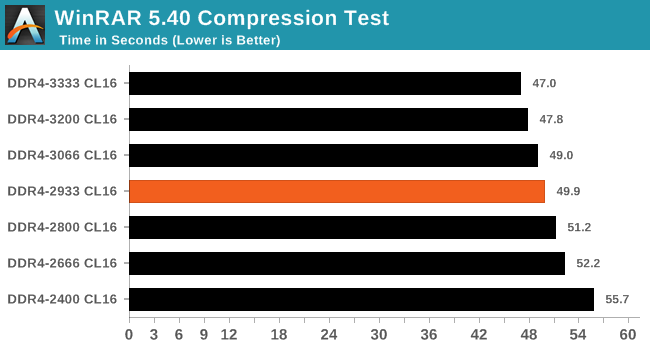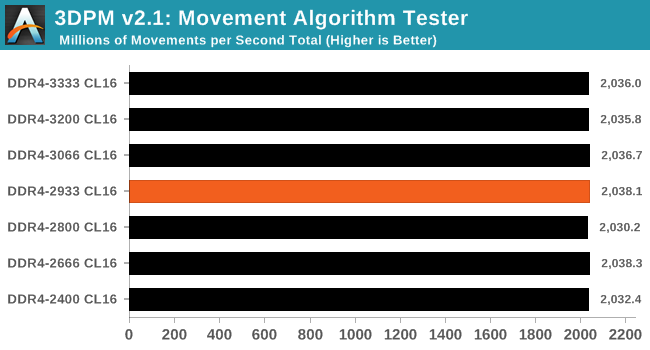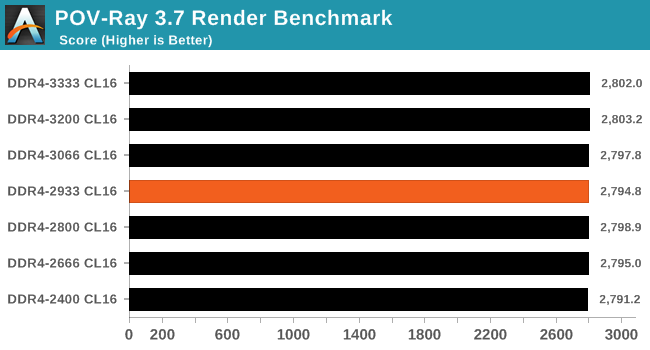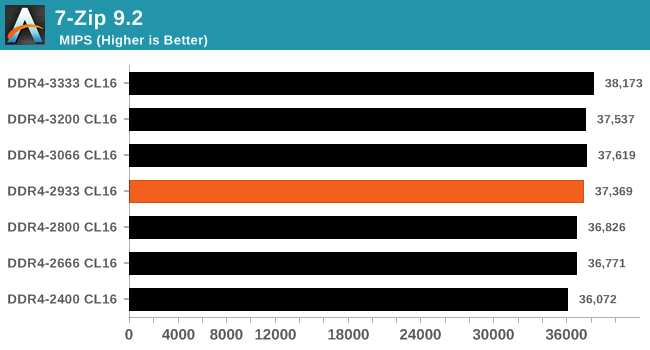Memory Scaling on Ryzen 7 with Team Group's Night Hawk RGB
by Ian Cutress & Gavin Bonshor on September 27, 2017 11:05 AM ESTCPU Performance, Short Form
For our quick reviews, we use our short form testing method.
Video Conversion – Handbrake v1.0.2: link
Video transcoding (both encode and decode) is a hot topic in performance metrics as more and more content is being created. First consideration is the standard in which the video is encoded, which can be lossless or lossy, trade performance for file-size, trade quality for file-size, or all of the above can increase encoding rates to help accelerate decoding rates. Alongside Google's favorite codec, VP9, there are two others that are taking hold: H264, the older codec, is practically everywhere and is designed to be optimized for 1080p video, and HEVC (or H265) that is aimed to provide the same quality as H264 but at a lower file-size (or better quality for the same size). HEVC is important as 4K is streamed over the air, meaning less bits need to be transferred for the same quality content.
Handbrake is a favored tool for transcoding, and so our test regime takes care of three areas.
Low Quality/Resolution H264: Here we transcode a 640x266 H264 rip of a 2 hour film, and change the encoding from Main profile to High profile, using the very-fast preset.

High Quality/Resolution H264: A similar test, but this time we take a ten-minute double 4K (3840x4320) file running at 60 Hz and transcode from Main to High, using the very-fast preset.

HEVC Test: Using the same video in HQ, we change the resolution and codec of the original video from 4K60 in H264 into 4K60 HEVC.

The biggest gains in Handbrake came in the HQ test where we gained up to an extra +21% in performance for DDR4-3333 over DDR4-2400. The fact that we don't see the same gains in the HEVC test is likely down to the algorithm.
Compression – WinRAR 5.40: link
For the 2017 test suite, we move to the latest version of WinRAR in our compression test. WinRAR in some quarters is more user friendly that 7-Zip, hence its inclusion. Rather than use a benchmark mode as we did with 7-Zip, here we take a set of files representative of a generic stack (33 video files in 1.37 GB, 2834 smaller website files in 370 folders in 150 MB) of compressible and incompressible formats. The results shown are the time taken to encode the file. Due to DRAM caching, we run the test 10 times and take the average of the last five runs when the benchmark is in a steady state.

Like with Handbrake, the system seemed to scale pretty well in WinRAR with a ~16% performance gain going from DDR4-2400 to DDR4-3333.
3D Movement Algorithm Test v2.1
This is the latest version of the self-penned 3DPM benchmark. The goal of 3DPM is to simulate semi-optimized scientific algorithms taken directly from my doctorate thesis. Version 2.1 improves over 2.0 by passing the main particle structs by reference rather than by value, and decreasing the amount of double->float->double recasts the compiler was adding in. It affords a ~25% speed-up over v2.0, which means new data.

Although more of a raw CPU benchmark, it shows here that memory isn’t a massive factor, as regardless of memory speed, we encountered marginal performance gains.
POV-Ray 3.7: link
Another regular benchmark in most suites, POV-Ray is another ray-tracer but has been around for many years. It just so happens that during the run up to AMD's Ryzen launch, the code base started to get active again with developers making changes to the code and pushing out updates. Our version and benchmarking started just before that was happening, but given time we will see where the POV-Ray code ends up and adjust in due course.

POV-Ray might be a fruitful benchmark for testing memory stability, but our performance variation between memory speeds was within the margin of error.
7-Zip 9.2: link
One of the freeware compression tools that offers good scaling performance between processors is 7-Zip. It runs under an open-source licence, is fast, and easy to use tool for power users. We run the benchmark mode via the command line for four loops and take the output score.

Some compression tools can be susceptible to memory performance and it shows in our results such as WinRAR. 7-zip has a small performance boost as we rise up through the stack, although the differences above DDR4-2666 are fairly minimal.










65 Comments
View All Comments
HStewart - Wednesday, September 27, 2017 - link
I think of this way, AMD was desperate to get back into business of CPU's, but financially they had some issues to really think it though. So they created an 8 Core Zen and then clunk them together so that they claim higher core count. This designed is likely primary why it does not scaled.But they did something that they probably didn't want to here - they ignored that Intel has been making higher core CPU's in the Xeon and that it quite simple for them to place them in gaming machines. This has a good side effect for Intel owners, because it means it keeps Intel on its toes - but the bad news I am afraid is that AMD will not be financially able to keep up with core wars and eventually have to drop - also purchasing ATI has alienated potential buyers - who in right mind would purchase an AMD GPU on Intel CPU.
One thing that is interesting, is that Intel and the industry is moving in a different direction. Mobile is where the industry is going not huge fat desktops. This is a place where AMD is missing the mark and could possible complete loose it enter company open and solely based there efforts on the desktop industry.
duploxxx - Thursday, September 28, 2017 - link
lol dude what have you been smoking?A) its intel that responded on AMD core count
B) Zen 8 core multi die was in the design from the start to keep cost low
C) Xeon v2 and v3 both had issues with scale out on core hence the reason for the new grid which is sub optimal on caching.
D) Intel has a way more expensive die, you forget that they ask 2500+ euro upto 14000 euro for there 16+ cores? while AMD charges 4000 euro for 32 cores. The gold series dont even come close to AMD offerings in cores.
E) Intel is not moving at all, they own the biggest part of the industry on x86 and that is what they try to keep. THey lost the low power war vs ARM and they sure try to get into IOT with lots of money but it aint that easy.
F)AMD has low budget so they infiltrate markets where they believe they can gain.
cap87 - Friday, September 29, 2017 - link
Intel didn’t respond to AMD with higher core counts, processors are designed years in advance, suggesting otherwise is just plain ignorance. What they did do was push forward the release date of Coffee Lake thanks to AMD’s pressure.jospoortvliet - Saturday, September 30, 2017 - link
Their design was meant for servers. Bringing the 18 cores suddenly to the high end desktop was most certain my something they kept as an ace option but it wasn't their original plan and that is obvious from the way it was rushed to market, being months later than the 10 core model and many of the earlier motherboards barely or simply not able to handle the load. They are also obviously clocked very high with barely room for overclock and breaking their tdp, throttling under heavy use on many boards even without oc.Hixbot - Monday, October 9, 2017 - link
I'm tired of hearing this. what you are suggesting is ignorance.Intel had loads of time to R&D, yes designs take years, but they've had those years to design coffe lake with 4 cores, with 8 cores. They design and design, they could have designed a sandy bridge as 8 core and not released it. You think they need to take years to respond to a competitive push. Let me tell you, they can design all sorts of options "years in advance" and only bring to market what they choose. So if it weren't for Zen, we might be staring at a 4 core (max) coffee lake. OMG it's hilarious to see this "design takes years" argument. They can and do take years to design all sorts of potential processors, they can then choose what to bring to market in a much shorter time.
Arbie - Wednesday, September 27, 2017 - link
For what? Some small and very expensive ST performance increase? Consider what AMD has done for us in reigniting competition and moving the tech envelope forward. Think what that took, and whether they could possibly do it again. Anyone who doesn't absolutely have to buy Intel this time around should give the nod to AMD. They've earned it, where Intel has not. Really, the tech is almost equal and in most regards AMD gives you more for the dollar. If we as consumers don't respond to that, vigorously, they may give up. How would you like an Intel-only future?Nagorak - Thursday, September 28, 2017 - link
Plenty of other tests have shown significant scaling. This is with loose subtimings. You can get even more performance from tight subtimings on top of faster memory speed. Remember Ryzen was only about 8% slower clock for clock than Kaby Lake. Faster memory speeds make up most of that difference, albeit Ryzen can't run at such high frequency as KL.notashill - Wednesday, September 27, 2017 - link
I'm curious if the higher clocked parts scale any better, presumably they were spending more time waiting on memory in the first place. The tests were done with a 1700, 1800X has 20% higher all-core clock.willis936 - Wednesday, September 27, 2017 - link
It would seem that 2 channels of DDR4 is not enough to keep 8 cores fed. It will be interesting to see if it's enough to keep 6 cores fed on coffee lake since intel's memory subsystem is higher performance but they also have higher single threaded performance (and may need more memory throughput as a result).sor - Wednesday, September 27, 2017 - link
“AGESA 1.0.0.6 BIOS updates were introduced several weeks ago”Shouldn’t that be several *months* ago, or was there some more recent AGESA release from the one being discussed in April/May?